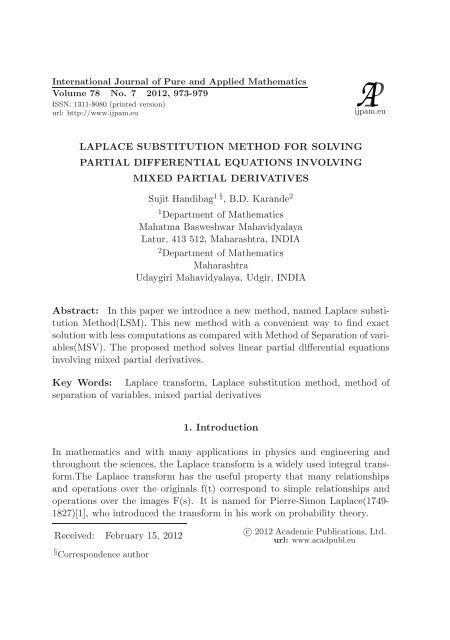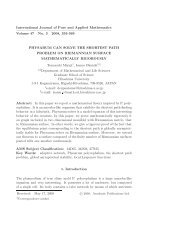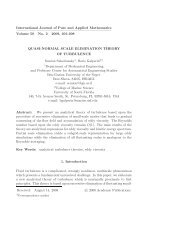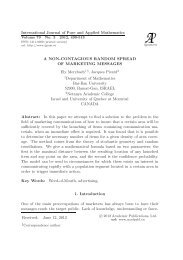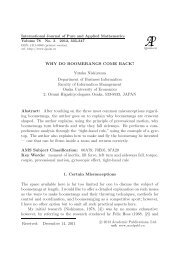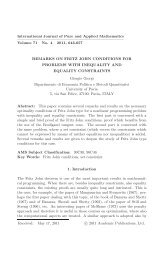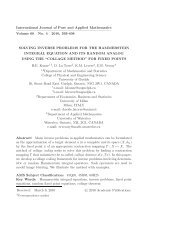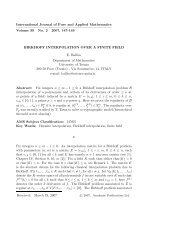LAPLACE SUBSTITUTION METHOD FOR SOLVING PARTIAL ...
LAPLACE SUBSTITUTION METHOD FOR SOLVING PARTIAL ...
LAPLACE SUBSTITUTION METHOD FOR SOLVING PARTIAL ...
You also want an ePaper? Increase the reach of your titles
YUMPU automatically turns print PDFs into web optimized ePapers that Google loves.
International Journal of Pure and Applied Mathematics<br />
Volume 78 No. 7 2012, 973-979<br />
ISSN: 1311-8080 (printed version)<br />
url: http://www.ijpam.eu<br />
<strong>LAPLACE</strong> <strong>SUBSTITUTION</strong> <strong>METHOD</strong> <strong>FOR</strong> <strong>SOLVING</strong><br />
<strong>PARTIAL</strong> DIFFERENTIAL EQUATIONS INVOLVING<br />
MIXED <strong>PARTIAL</strong> DERIVATIVES<br />
Sujit Handibag 1 § , B.D. Karande 2<br />
1 Department of Mathematics<br />
Mahatma Basweshwar Mahavidyalaya<br />
Latur, 413 512, Maharashtra, INDIA<br />
2 Department of Mathematics<br />
Maharashtra<br />
Udaygiri Mahavidyalaya, Udgir, INDIA<br />
PA<br />
ijpam.eu<br />
Abstract: In this paper we introduce a new method, named Laplace substitution<br />
Method(LSM). This new method with a convenient way to find exact<br />
solution withless computations as compared with Method of Separation of variables(MSV).<br />
The proposed method solves linear partial differential equations<br />
involving mixed partial derivatives.<br />
Key Words: Laplace transform, Laplace substitution method, method of<br />
separation of variables, mixed partial derivatives<br />
1. Introduction<br />
In mathematics and with many applications in physics and engineering and<br />
throughout the sciences, the Laplace transform is a widely used integral transform.The<br />
Laplace transform has the useful property that many relationships<br />
and operations over the originals f(t) correspond to simple relationships and<br />
operations over the images F(s). It is named for Pierre-Simon Laplace(1749-<br />
1827)[1], who introduced the transform in his work on probability theory.<br />
Received: February 15, 2012<br />
§ Correspondence author<br />
c○ 2012 Academic Publications, Ltd.<br />
url: www.acadpubl.eu
974 S. Handibag, B.D. Karande<br />
In mathematics, partial differential equations (PDE) are differential equationsthatcontainunknownmultivariablefunctionsandtheirpartialderivatives.<br />
PDEs are used to formulate problems involving functions of several variables,<br />
and are either solved by hand, or used to create a relevant computer model.<br />
The separation of variables is any of several methods for solving ordinary and<br />
partial differential equations, in which algebra allows one to rewrite an equation<br />
so that each of two variables occurs on a different side of the equation.<br />
The main goal of this paper is to describe new method for solving linear<br />
partial differential equations involving mixed partial derivatives. This powerful<br />
method will be proposed in Section 2; in Section 3 we will apply it to some<br />
examples and in last section we give some conclusion.<br />
2. Laplace Substitution Method<br />
The aim of this section is to discuss the use of Laplace substitution method.<br />
We consider the general form of nonhomogeneous partial differential equation<br />
with initial conditions is given below<br />
Lu(x,y)+Ru(x,y) = h(x,y) (2.1)<br />
u(x,0) = f(x). uy(0,y) = g(y). (2.2)<br />
Here L= ∂2<br />
∂x∂y , Ru(x,y) is the remaining linear terms in which contains only first<br />
order partial derivatives of u(x,y) with respect to either x or y and h(x,y) is the<br />
source term. We can write equation (2.1) in following form<br />
putting ∂u<br />
∂y<br />
∂2u +Ru(x,y) = h(x,y)<br />
∂x∂y<br />
<br />
∂ ∂u<br />
+Ru(x,y) = h(x,y) (2.3)<br />
∂x ∂y<br />
= U in equation (2.3), we get<br />
∂U<br />
∂x<br />
+Ru(x,y) = h(x,y) (2.4)<br />
Taking Laplace transform of equation (2.4) with respect to x, we get<br />
sU(s,y)−U(0,y) = Lx[h(x,y)−Ru(x,y)]<br />
U(s,y) = 1 1<br />
U(0,y)+<br />
s s Lx[h(x,y)−Ru(x,y)]
<strong>LAPLACE</strong> <strong>SUBSTITUTION</strong> <strong>METHOD</strong> <strong>FOR</strong> <strong>SOLVING</strong>... 975<br />
U(s,y) = 1 1<br />
uy(0,y)+<br />
s s Lx[h(x,y)−Ru(x,y)]<br />
U(s,y) = 1 1<br />
g(y)+<br />
s s Lx[h(x,y)−Ru(x,y)] (2.5)<br />
Taking inverse Laplace transform of equation (2.5) with respect to x, we get<br />
U(x,y) = g(y)+L −1<br />
<br />
1<br />
x<br />
s Lx[h(x,y)−Ru(x,y)]<br />
<br />
resubstitute the value of U(x,y) in equation (2.6), we get<br />
∂u(x,y)<br />
∂y<br />
= g(y)+L −1<br />
<br />
1<br />
x<br />
s Lx[h(x,y)−Ru(x,y)]<br />
<br />
(2.6)<br />
(2.7)<br />
This is the first order partial differential equation in the variables x and y.<br />
Taking the Laplace transform of equation (2.7) with respect to y, we get<br />
su(x,s) = f(x)+Ly<br />
<br />
g(y)+L −1<br />
<br />
1<br />
x<br />
s Lx[h(x,y)−Ru(x,y)]<br />
<br />
u(x,s) = 1 1<br />
f(x)+<br />
s s Ly<br />
<br />
g(y)+L −1<br />
<br />
1<br />
x<br />
s Lx[h(x,y)−Ru(x,y)]<br />
<br />
(2.8)<br />
Taking the inverse Laplace transform of equation (2.8) with respect to y,<br />
we get<br />
u(x,y) = f(x)+L −1<br />
<br />
1<br />
y<br />
s Ly<br />
<br />
g(y)+L −1<br />
<br />
1<br />
x<br />
s Lx[h(x,y)−Ru(x,y)]<br />
<br />
(2.9)<br />
The last equation (2.9) gives the exact solution of initial value problem<br />
(1.1).<br />
3. Applications<br />
To illustrate this method for coupled partial differential equations we take four<br />
examples in this section.<br />
Example 1. Consider the partial differential equation<br />
∂ 2 u<br />
∂x∂y = e−y cosx (3.10)
976 S. Handibag, B.D. Karande<br />
with initial conditions<br />
u(x,0) = 0. uy(0,y) = 0. (3.11)<br />
In the above initial value problem Lu(x,y) = ∂2 u<br />
∂x∂y , h(x,y) = e−y cosx and<br />
general linear term Ru(x,y) is zero.<br />
Equation (3.10) we can write in the following form<br />
putting ∂u<br />
∂y<br />
∂<br />
∂x<br />
= U in equation (3.12), we get<br />
<br />
∂u<br />
= e<br />
∂y<br />
−y cosx (3.12)<br />
∂U<br />
∂x = e−y cosx (3.13)<br />
This is the nonhomogeneous partial differential equation of first order. Taking<br />
Laplace transform on both sides of equation (3.13) with respect to x, we get<br />
−y<br />
sU(s,y)−U(0,y) = Lx e cosx<br />
U(s,y) = e −y1<br />
s<br />
s<br />
(1+s 2 )<br />
Taking inverse Laplace transform of equation (3.13) with respect to x, we get<br />
U(x,y) = e −y sinx<br />
∂u(x,y)<br />
∂y<br />
= e −y sinx (3.14)<br />
This is the partial differential equation of first order in the variables x and y.<br />
Taking Laplace transform of equation (3.14) with respect to y, we get<br />
1<br />
su(x,s)−u(x,0) = sinx<br />
(1+s)<br />
1<br />
u(x,s) = sinx<br />
s(1+s)<br />
(3.15)<br />
Taking inverse Laplace transform of equation (3.15) with respect to y, we get<br />
u(x,y) = sinx(1−e −y ) (3.16)
<strong>LAPLACE</strong> <strong>SUBSTITUTION</strong> <strong>METHOD</strong> <strong>FOR</strong> <strong>SOLVING</strong>... 977<br />
This is the required exact solution of equation (3.10). Which can be verify<br />
through the substitution. Which is same the solution obtained by (MSV)[2,3].<br />
Example 2. Consider the partial differential equation<br />
with initial conditions<br />
∂2u = sinxsiny (3.17)<br />
∂y∂x<br />
u(x,0) = 1+cosx, uy(0,y) = −2siny. (3.18)<br />
In the above example assume that ux(x,y) and uy(x,y) both are differentiable<br />
in the domain of definition of function u(x,y)[Young’s Theorem]. This implies<br />
. Given initial conditions (3.18) force to write the equation<br />
that ∂u<br />
∂x∂y<br />
= ∂u<br />
∂y∂x<br />
(3.17) in following form and use the substitution ∂u<br />
∂y<br />
∂u<br />
∂x<br />
= U<br />
<br />
∂u<br />
= sinxsiny (3.19)<br />
∂y<br />
∂U<br />
= sinxsiny<br />
∂x<br />
(3.20)<br />
Taking the Laplace transform of equation (3.20) with respect to x, we get<br />
U(s,y) = −2siny<br />
<br />
1 s<br />
+siny −<br />
s s 1+s 2<br />
<br />
(3.21)<br />
Taking inverse Laplace transform of equation (3.21) with respect to x, we get<br />
U(x,y) = −2siny +siny[1−cosx]<br />
∂u(x,y)<br />
∂y<br />
= −2siny+siny[1−cosx] (3.22)<br />
Taking Laplace transform of equation (3.22) with respect to y, we get<br />
su(x,s)−u(x,0) = 1<br />
[−1−cosx]<br />
1+s 2<br />
su(x,s) = (1+cosx)− 1<br />
1+s<br />
<br />
1<br />
u(x,s) = (1+cosx)<br />
s −<br />
1<br />
s(1+s 2 <br />
)<br />
2 [1+cosx]<br />
(3.23)
978 S. Handibag, B.D. Karande<br />
Taking inverse Laplace transform of equation (3.23) with respect to y, we get<br />
u(x,y) = (1+cosx)cosy (3.24)<br />
This is the required exact solution of equation (3.17). Which can be verify<br />
through the substitution. Which is same the solution obtained by (MSV)[2,3].<br />
Example 3. Considerthefollowing partial differential equation with Ru(x,<br />
y) = 0<br />
∂2u ∂u<br />
+<br />
∂x∂y ∂x +u = 6x2y (3.25)<br />
with initial conditions<br />
u(x,0) = 1, u(0,y) = y, uy(0,y) = 0 (3.26)<br />
In the above example Ru(x,y) = ∂u(x,y)<br />
∂x<br />
= U(x,y) in equation (3.25), we get<br />
∂ 2 U<br />
∂x<br />
+u(x,y). Use the substitution ∂u(x,y)<br />
∂y<br />
+ ∂u<br />
∂x +u = 6x2 y (3.27)<br />
Taking Laplace transform of equation (3.27) with respect to x, we get<br />
sU(s,y)−U(0,y)+su(s,y)−u(0,y)+Lx[u(x,y)] = 12y<br />
s 3<br />
U(s,y) = −u(s,y)+ 12y 1<br />
−<br />
s4 s Lx[u(x,y)] (3.28)<br />
Taking inverse Laplace transform of equation (3.28) with respect to x, we get<br />
U(x,y) = −u(x,y)+2yx 3 −L −1<br />
<br />
1<br />
x<br />
s Lx[u(x,y)]<br />
<br />
∂u(x,y)<br />
∂x = −u(x,y)+2yx3 −L −1<br />
<br />
1<br />
x<br />
s Lx[u(x,y)]<br />
<br />
(3.29)<br />
Taking Laplace transform of equation (3.29) with respect to y, we get<br />
<br />
3 1<br />
su(x,s)−u(x,0) = 2x −Ly u(x,y)+L<br />
s2 −1<br />
<br />
1<br />
x<br />
s Lx[u(x,y)]<br />
<br />
u(x,s) = 1 1 1<br />
+2x3 −<br />
s s3 s Ly<br />
<br />
u(x,y)+L −1<br />
<br />
1<br />
x<br />
s Lx[u(x,y)]<br />
<br />
(3.30)
<strong>LAPLACE</strong> <strong>SUBSTITUTION</strong> <strong>METHOD</strong> <strong>FOR</strong> <strong>SOLVING</strong>... 979<br />
Taking inverse Laplace transform of equation (3.30) with respect to y, we get<br />
u(x,y) = 1+x 3 y 2 −L −1<br />
<br />
1<br />
y<br />
s Ly<br />
<br />
u(x,y)+L −1<br />
<br />
1<br />
x<br />
s Lx[u(x,y)]<br />
<br />
(3.31)<br />
We can not solve the equation (3.31) because our goal u(x,y) is appeared in<br />
both sides of equation (3.31). Thus the equation (3.25) we can not solve by<br />
using LSM because of Ru(x,y) = 0.<br />
4. Conclusion<br />
In this paper, Laplace Substitution Method (LSM) is applied to solve partial<br />
differential equations inwhichinvolves themixedpartial derivatives andgeneral<br />
linear term Ru(x,y) is zero. The result of two examples compared with (MSV)<br />
[2,3], tell usthatbothmethodscanbeusealternatively forthesolution ofhigher<br />
order initial value problem in which involves the mixed partial derivatives with<br />
general linear term Ru(x,y) is zero. But the result of example 3 tell us that<br />
LSM is not applicable for those partial differential equations in which Ru(x,y)=<br />
0.<br />
References<br />
[1] Joel L. Schiff, The Laplace Transform: Theory and Applications, Springer.<br />
[2] William E. Boyce, Richard C. DiPrima, Elementary Differential Equations<br />
and Boundary Value Problems, Seventh Addition, John Wiley and Sons,<br />
Inc. (2001).<br />
[3] Wikipedia: Separation of variables (redirect from Method of Sepration of<br />
Variable).<br />
[4] Yehuda Pinchover and Jacob Rubinstein, An Introduction To Partial Differntial<br />
Equations, Cambridge University Press (2005).<br />
[5] Richard Jozsa, DAMTP Cambridge, PDEs on Bounded Domains: Separation<br />
of Variables, Part II (2011).
980


